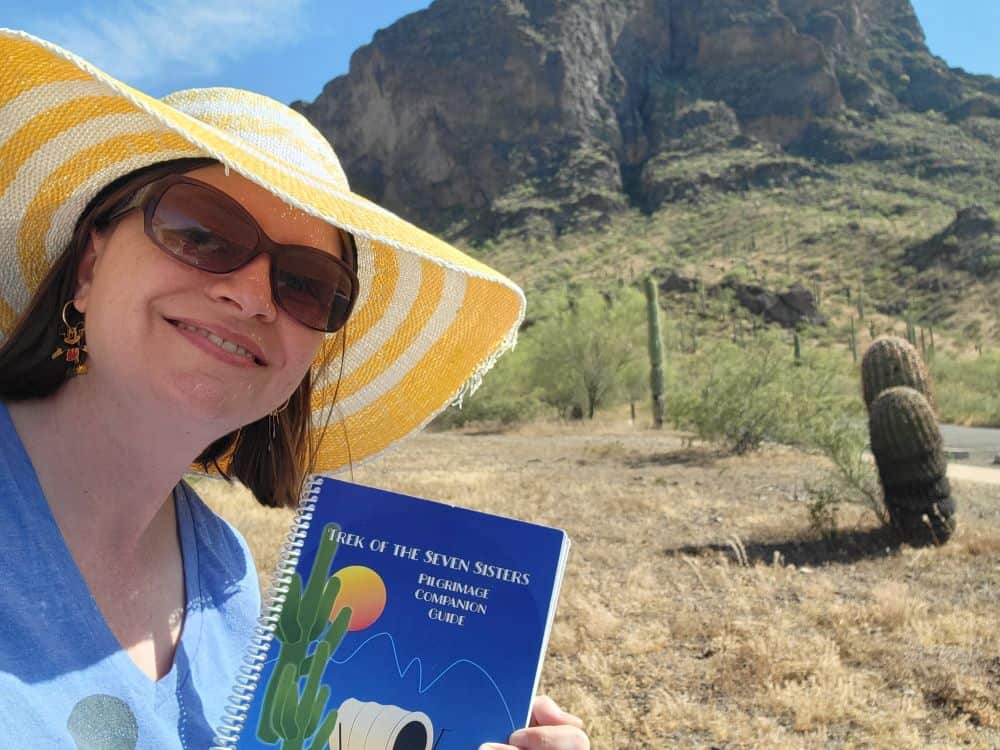
In 1870, seven sisters traveled west from St. Louis to San Francisco, and then on to their final destination of Tucson, Arizona. Their journey would last 37 days and span nearly 3,000 miles. They would travel by train, ship, covered wagon, and even on foot. In those days, there was no direct train route to Tucson, and the western part of the country was sparsely populated and largely undeveloped. Without knowing exactly what obstacles they might encounter, the sisters bravely volunteered to travel to Tucson in response to Bishop Lamy’s request for sisters to serve in the Arizona territory.

Sister Monica Corrigan (1843-1929, third from left in the back row above) was one of those pioneer sisters, and she had the foresight to document their trip in a journal. Thanks to her writings, we can experience the trek ourselves through her eyes. While the trek was long, hot and perilous, their arrival led to the historic first foundation of the congregation in the west. (The western provincial house resided in Tucson until 1890 before relocating to Los Angeles and becoming what we now call the Los Angeles Province.)
Recreating the Trek today
In recent years, sisters from the Los Angeles Province have recreated the main part of the trek from San Diego to Tucson almost every May. The journey is a pilgrimage revolving around prayer, reflection and visiting the same historic sites that the seven sisters saw in 1870.
This year, I was fortunate in my role as director of the Carondelet Consolidated Archives to be part of a group of ten making the trek to Tucson from May 15-19. While we had the 21st-century luxuries of traveling by car, sleeping at motels and having other modern amenities at our disposal (including cell phones and GPS), there were still many opportunities to connect spiritually with those original pioneer sisters and see many of the same sights as they did, which mostly still look the same as they did 153 years ago.
Day One
Our journey began on May 15 at Carondelet Center in Los Angeles and lasted five days. While the original seven sisters took a ship from Los Angeles to San Diego, we drove south along the coast, arriving in San Diego by afternoon.


We visited Mission San Diego de Alcala, where the sisters served at the former St. Anthony Industrial School from about 1891-1907. We stood in front of the same large, rounded wooden doors that our sisters posed in front of in the 1890s with the local children. At this stop, as well as at all the stops on our five-day journey, the group would open our Pilgrimage Companion Guide books, read the original journal entry, learn about the significance of the site and pray together, all the time keeping those original seven sisters on our hearts and minds.
Day Two
On day two, our journey continued onto Yuma, Arizona. Along the way, we stopped and walked along the Old Wagon Trail Road near Campo, California, where our pioneer sisters were proposed to by a group of lonely men. As we traveled closer to the U.S./Mexico border, we found the large flat rocks that the sisters slept on one night in the mountains.

We then saw what the pioneer sisters called the “Abomination of Isolation”: dangerous rocky terrain and mountains appearing to crumble into rock with little to no vegetation growing on them. The original sisters’ path led them through Mexico to avoid these menacing mountains, but we stayed on the main road, only viewing Mexico (and the visible border wall) from a short distance.
After passing through the most desolate part of our journey, we drove past the Buttercup Sand Dunes and arrived in Yuma. We then proceeded to drive by St. Thomas Mission and the nearby grounds of what was the Fort Yuma Government School, where the sisters taught from about 1886-1900. The temperature was 101 degrees by late afternoon.
Day Three
Day three began with an early morning stop by the Colorado River, where the sisters’ covered wagon crossed on a raft. It was not the same wide, raging river that almost caused the sisters’ raft to capsize when they floated over the river in their covered wagon. The river was hardly flowing in this particular area, which was near the bridge and below the bluff where St. Thomas Mission sits.

Later that morning, our group made a fun stop at Dateland, where we purchased souvenirs and tried refreshing ice cream shakes made from interesting ingredients such as dates and cacti.

We also visited the Painted Rock Petroglyph Site, which is a sacred site of the Indigenous Peoples of the region. There you can see ancient painted symbols on the large rocks.
Perhaps the highlight of the day’s journey was seeing Picacho Peak off in the distance as we neared the outskirts of Tucson. This is where soldiers met the pioneer sisters to protect them for the remainder of their journey. I think we all felt a sense of relief knowing where we had come from on our journey, and it was momentous to reach Picacho Peak, which was the last main natural attraction to encounter before arriving in Tucson.
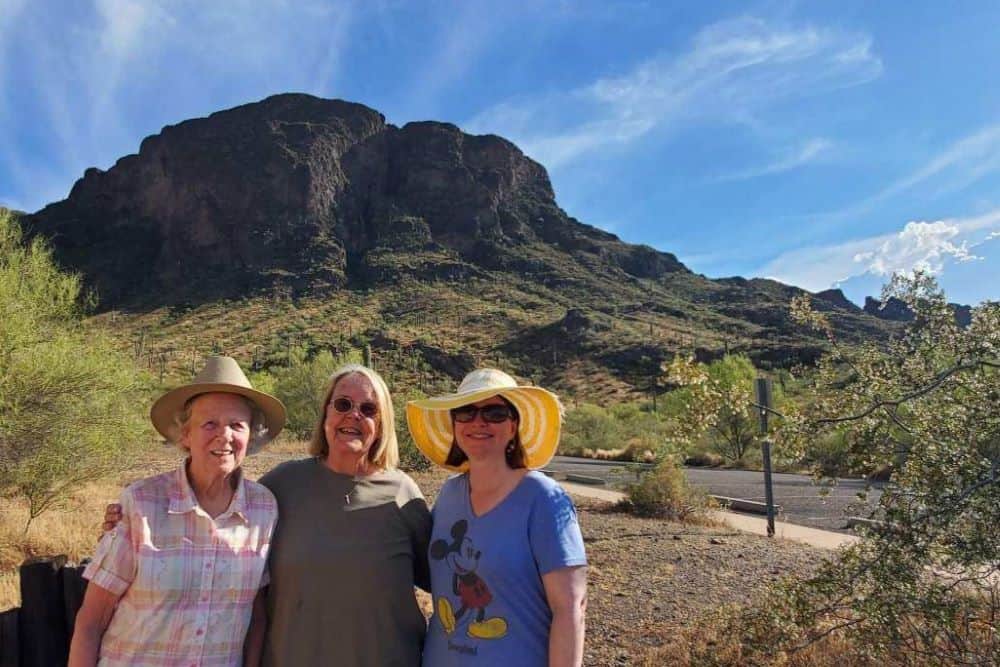
Like those early sisters, our days’ journey ended when we arrived in Tucson.
Day Four
On day four, we traveled all around Tucson visiting some of the congregation’s early missions. We paid our respects to the many sisters buried at Holy Hope Cemetery, including the remains of five of the original seven sisters, whose grave markers were recently updated to include little wagon illustrations to denote their place in history.

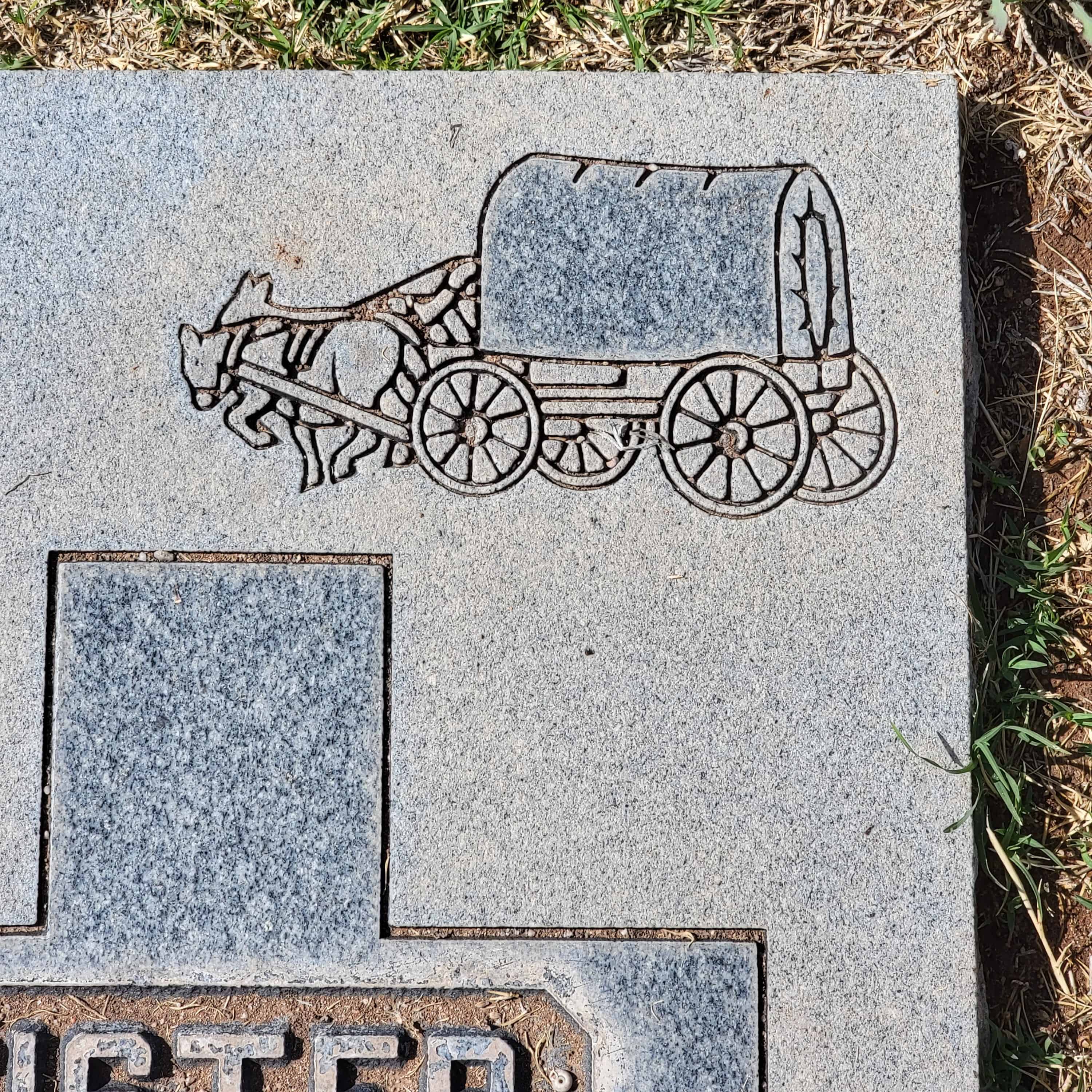
We visited the site of the original cathedral and St. Joseph’s Academy (where a few foundation stones remain), the second St. Joseph’s Academy (now loft apartments), the current St. Mary’s Hospital, and St. Augustine Cathedral, which honored the sisters by constructing a special “Seven Sisters Plaza” memorial in 2020 to commemorate the arrival of the pioneer sisters.
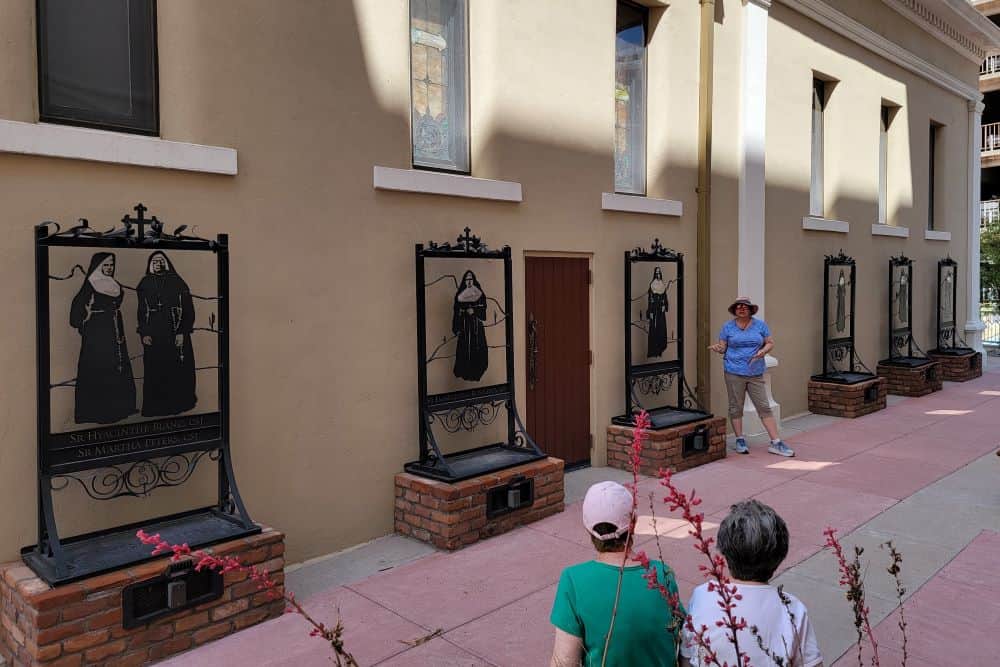
We also drove a short distance to San Xavier del Bac Mission, where the sisters taught on and off from 1873-1932. The mission was one of the larger ones we would see, with a bright white exterior that shines in the desert sun. Our last stop of the day was the site of the former St. Joseph Children’s Home that housed children during the Spanish Flu outbreak.
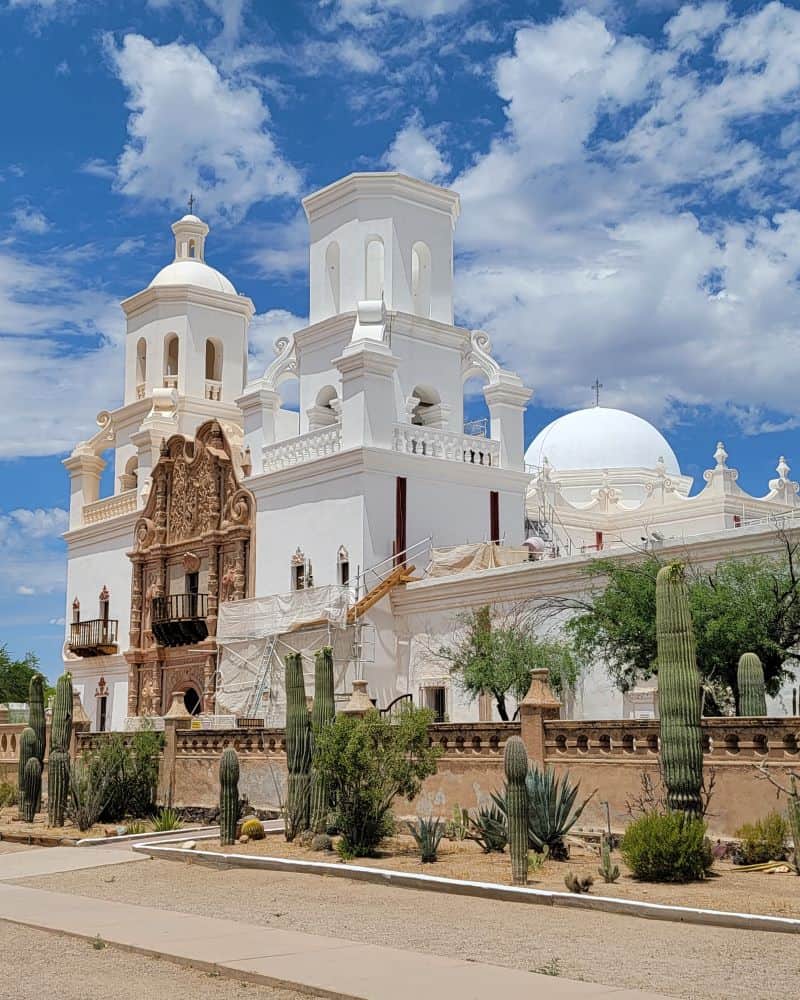
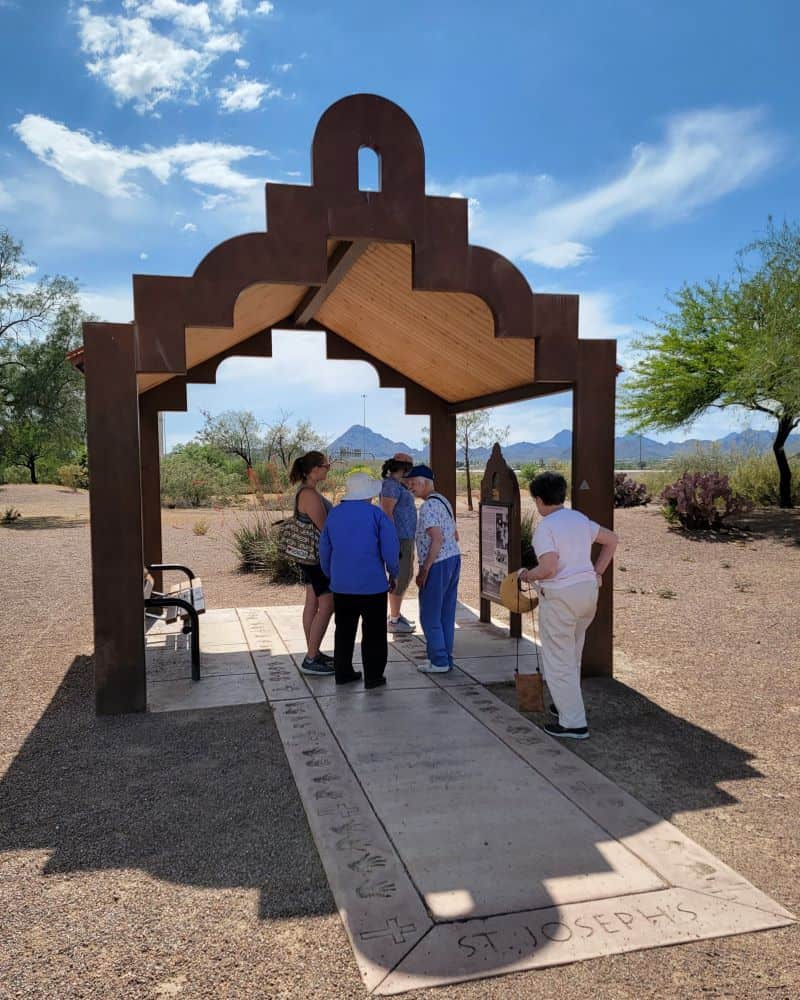
Day Five
Our final day consisted of a long drive back to Los Angeles, but not before making stops at two more mission sites. First, we visited St. John’s Mission in Komatke, a village in the Gila River Reservation adjacent to the town of Laveen. The sisters staffed the former school from about 1901-1938.

The next stop was Banning, California. We drove near the now vacant land that housed the former St. Boniface Church and School, where the sisters taught from about 1890-1900. By evening, we safely arrived back at our starting point at Carondelet Center in Los Angeles.
In those five short days, our humble group of ten formed bonds and friendships that we will carry with us forever. The views and scenery were breathtaking at every turn. As a native St. Louisan, I was intrigued by the desert plants, such as the tall and unyielding saguaro cactus, the cane-like spiny stems of the ocotillo and the fuzzy-looking cholla.
Each person who participates in the trek to Tucson will be inspired or empowered by something different. No two people will have the exact same experience. For me, the starkness of the natural land was a powerful reminder that there is beauty in everything that God creates. I’m also in awe of the sisters’ perseverance. They followed through on their mission and never gave up despite their hardships. I felt this throughout the entire trip. I could vividly imagine what they felt as they encountered unfamiliar plant life, desert land and harsh mountains. I thought of them sleeping on the large flat rock near the Mexican border and how uncomfortable that might have been. I sat in pews of old, but beautifully maintained missions and thought of the sisters praying in those same spaces. The sisters never gave up. They followed through on their mission, and if they could succeed under those conditions, then surely I can learn to grow in even my daily experiences.
I highly recommend reading the official Pilgrimage Companion Guide, which outlines the history of the western foundation, reprints the original journal in its entirety and offers reflection for each stop on the trek.
I was a nurse at Carobdelet St. Joseph’s Hospital for nearly 45 years. I was fortunate to participate in Mission and Mentoring during that time with Sr. Barbara Stowaser. Our group also followed much of the trek from Tucson, to LA to San Diego, Yuma, Picacho and back. It was a beautiful experience and journey and was so meaningful. What a privilege it was for me to continue the work of the sisters! We watched a movie recreating the Trek; I think Helen Hayes may have starred in it, but I cannot seem to find it. Are you aware of this movie or how to locate it? I would love to see it again. Thank you for your role in documenting this beautiful story and important history of our Carondelet Sisters.
Hi Kris, I’m glad you enjoyed this blog post. Yes, Helen Hayes starred in Four Women in Black, a 1957 TV episode of a show called Playhouse 90. It is not available for public viewing as far as I can tell. It occasionally is uploaded to YouTube but then taken down for copyright reasons. The Carondelet Consolidated Archives has a copy that was recorded off television many years ago and is available for viewing in the archives, but otherwise cannot be shared (also due to copyright permissions).
Thank you for the response Catherine. I love the legacy of the sisters and am forever grateful for their dedication and service.
Hello. My name is Kaye Guerin Marks and I live in Tucson. I am an artist and learning about Arizona history and am wondering where the first novitiate was created by the nuns in 1871. Was it at what is now Mission Gardens at the base of A Mountain? Are there any similar structures in Tucson that remain? I read that it became an orphanage to 30 children and that the nuns fed the local miners a dinner outside each day.
Thanks so much.
Thank you for reaching out! We followed up via email so we could share more detailed info.